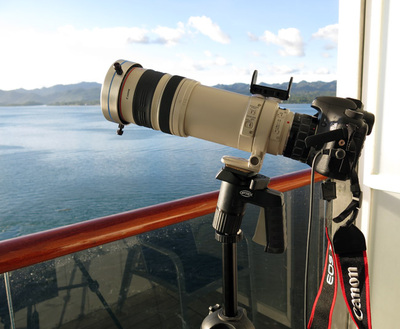
Usually sunspots don’t last all that long as they are sometimes extremely active and once they’ve release there energy they will fade away. If they are long lived they can often come back into view when the Sun rotates on its axis and is again facing us here on Earth.
This is what happened on the 29th January, sunspot group AR1944 returned again on the limb of the Sun. When this happens, astronomers designate a new number to the sunspot and they renamed it AR1967… and it was still massive and active!
When this sunspot group returned we had just left on a flight to Sydney for our holidays on a cruise ship (think moving surface) and I didn’t know if I could take any new images. So I decided to pack my glass solar filter anyway and give it a try, it just so happened that our cabin faced west on the day of departure in Sydney (30th January 2014) and I was able to get some excellent images from the balcony of the ship :-)

The next chance that I got was when the ship reached the Port of Suva in Fiji on the 4th February 2014…it was so hot 37 degrees and 100% humidity…. but I managed to obtain some images, and yes, I was lucky enough to be on the western side of the ship and could take my pictures from our balcony again.
I just had enough room on the balcony to set up the tripod. The Sol Searcher that you’ll see on top of my lens is a little beauty, it saves you from looking directly at the Sun…all you have to do is point your lens in the general direction of the Sun and there it is… the Suns disc on the little screen, it's so easy to do and very safe :-)

~ Following the Sun ~
On the 25th February, low and behold sunspot AR1967 which was originally know as AR1944 returned for a third time in spectacular fashion with an incredible outburst on the limb of the Sun. This produced a CME that lit up both northern and southern atmospheres of the Earth and produced stunning aurora’s to the delight of aurora lovers, this time it was renamed AR 1990 and I took the images from my home here in Queensland. I’ve included an image of the flare from AR1990 from NASA’s SDO (Solar Dynamics Observatory) http://sdo.gsfc.nasa.gov/
I’ve had a lot of fun watching this incredible feature on the surface of the Sun and I’ve found that the simple equipment of a Canon 7D Camera and telephoto lens on a manual tripod is very portable and easy to set up to capture the pictures. (Canon 100-400mm lens with 2x converter and Orion Solar Filter attached to lens)
If I had to set up my tracking tripod and telescope I would never have been able to get my images so quickly…so perhaps the moral of this story is ’Keep It Simple Sweetie’…KISS :-))





 RSS Feed
RSS Feed
